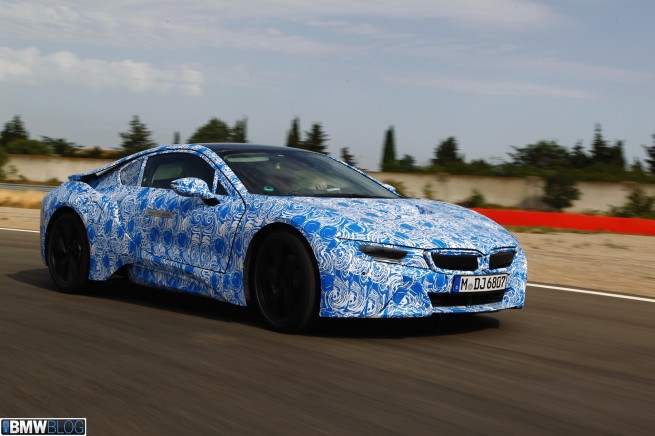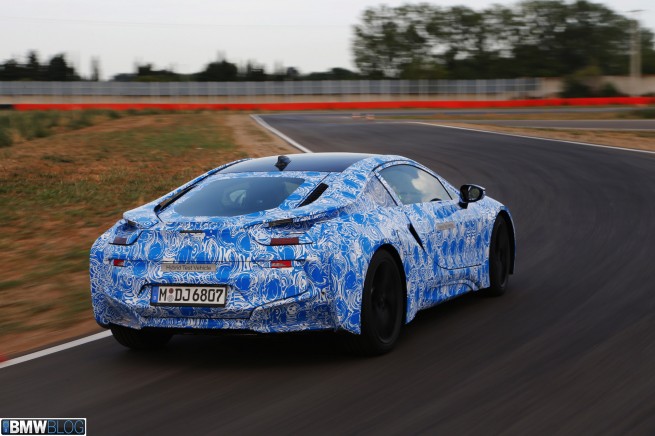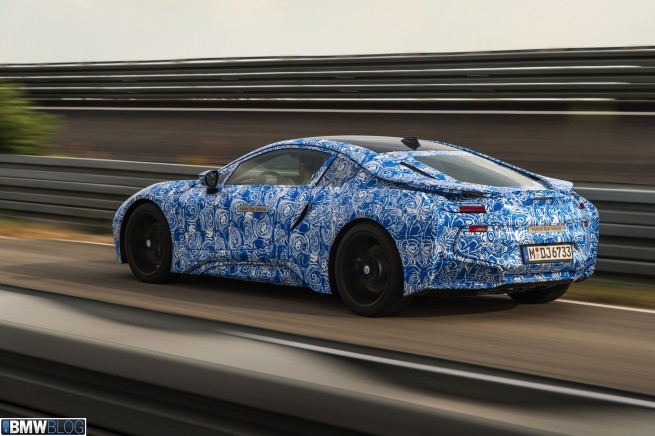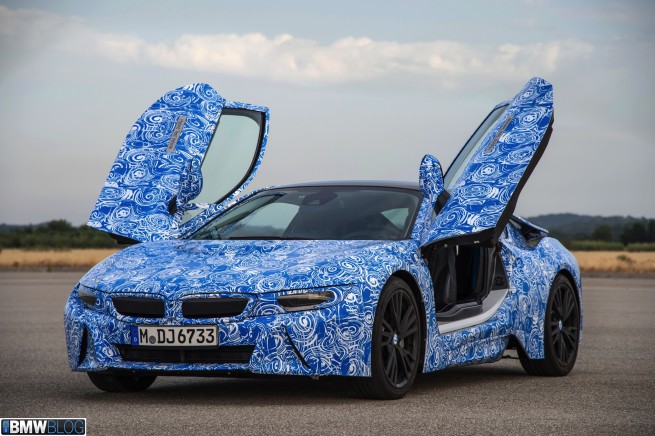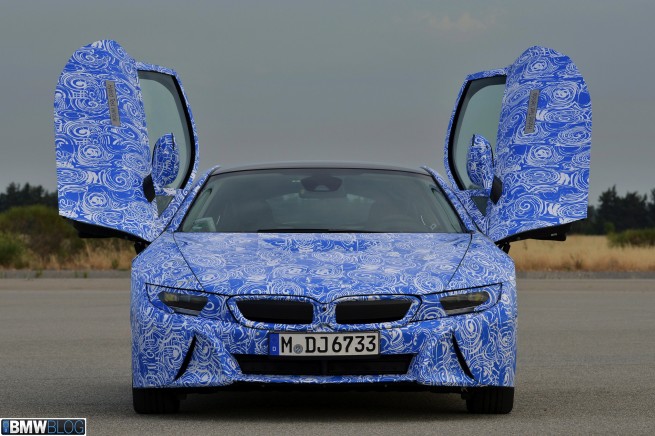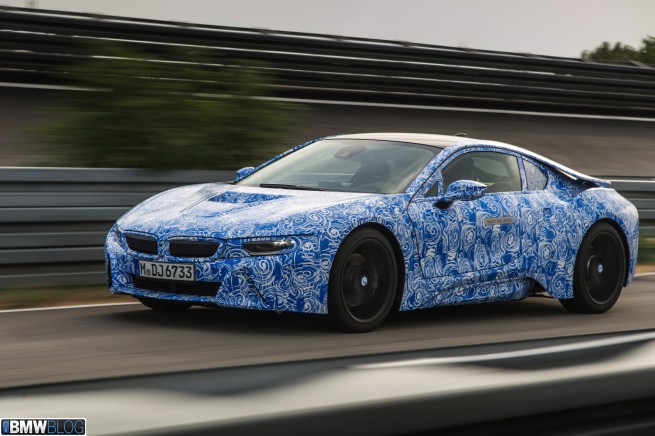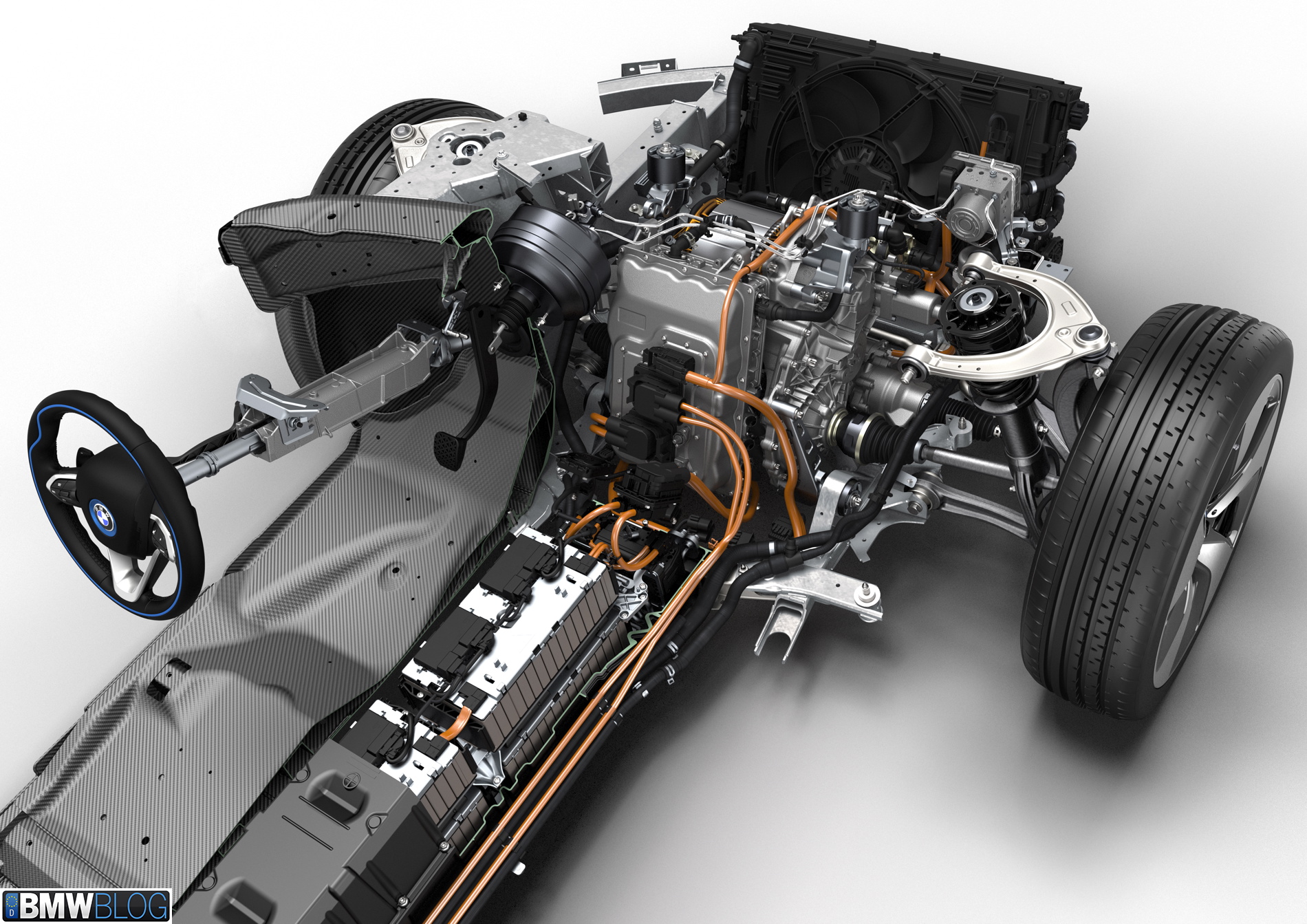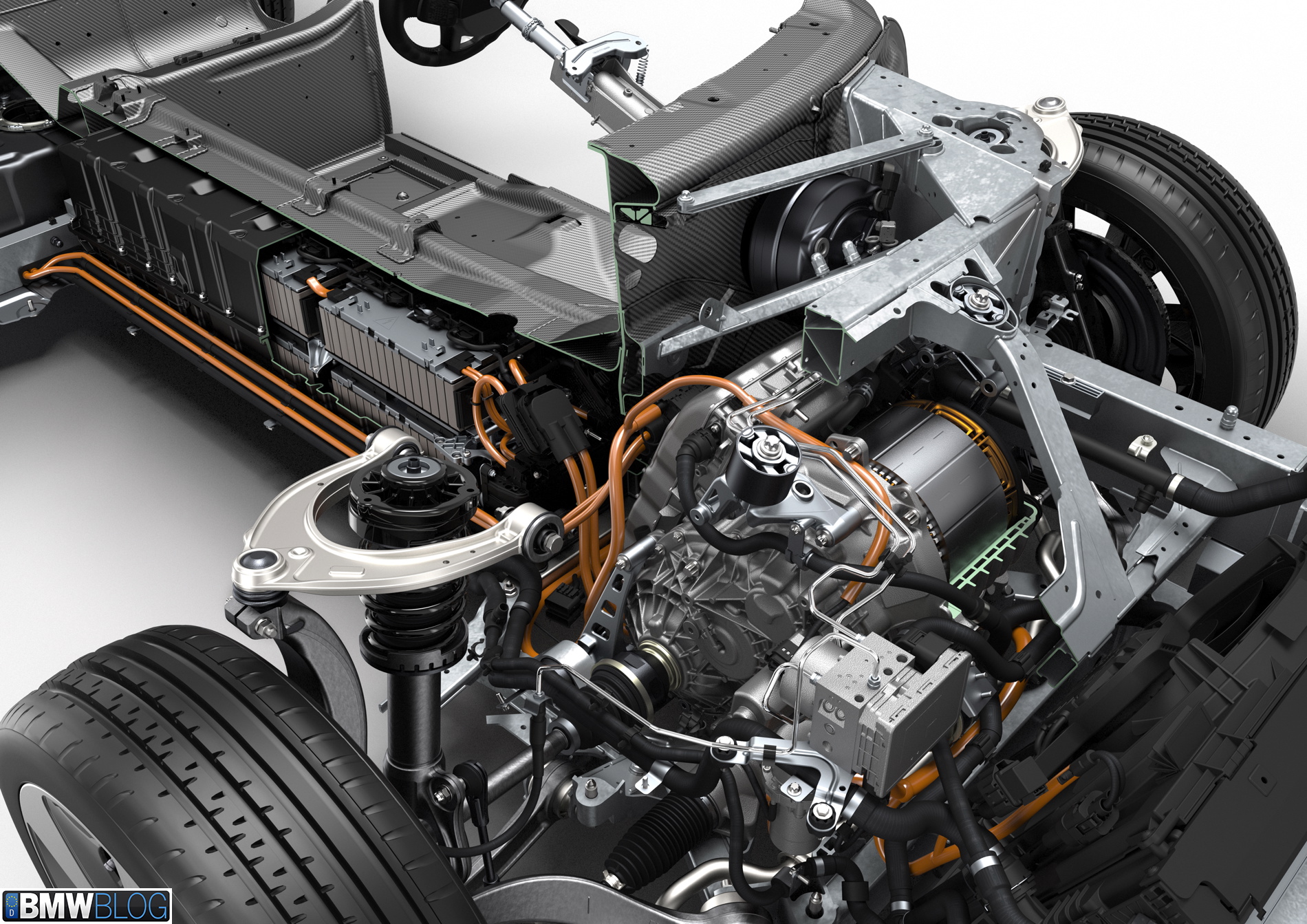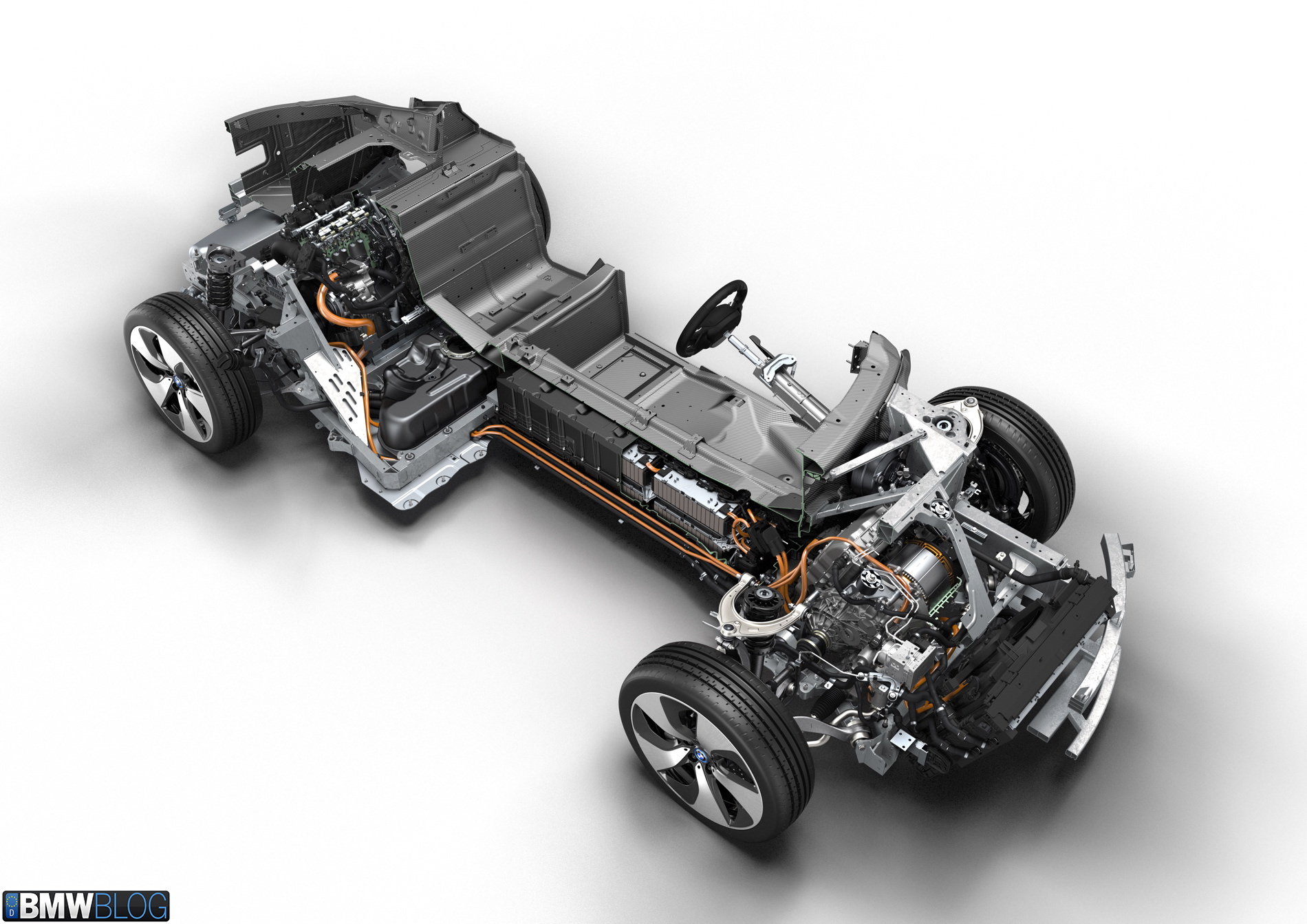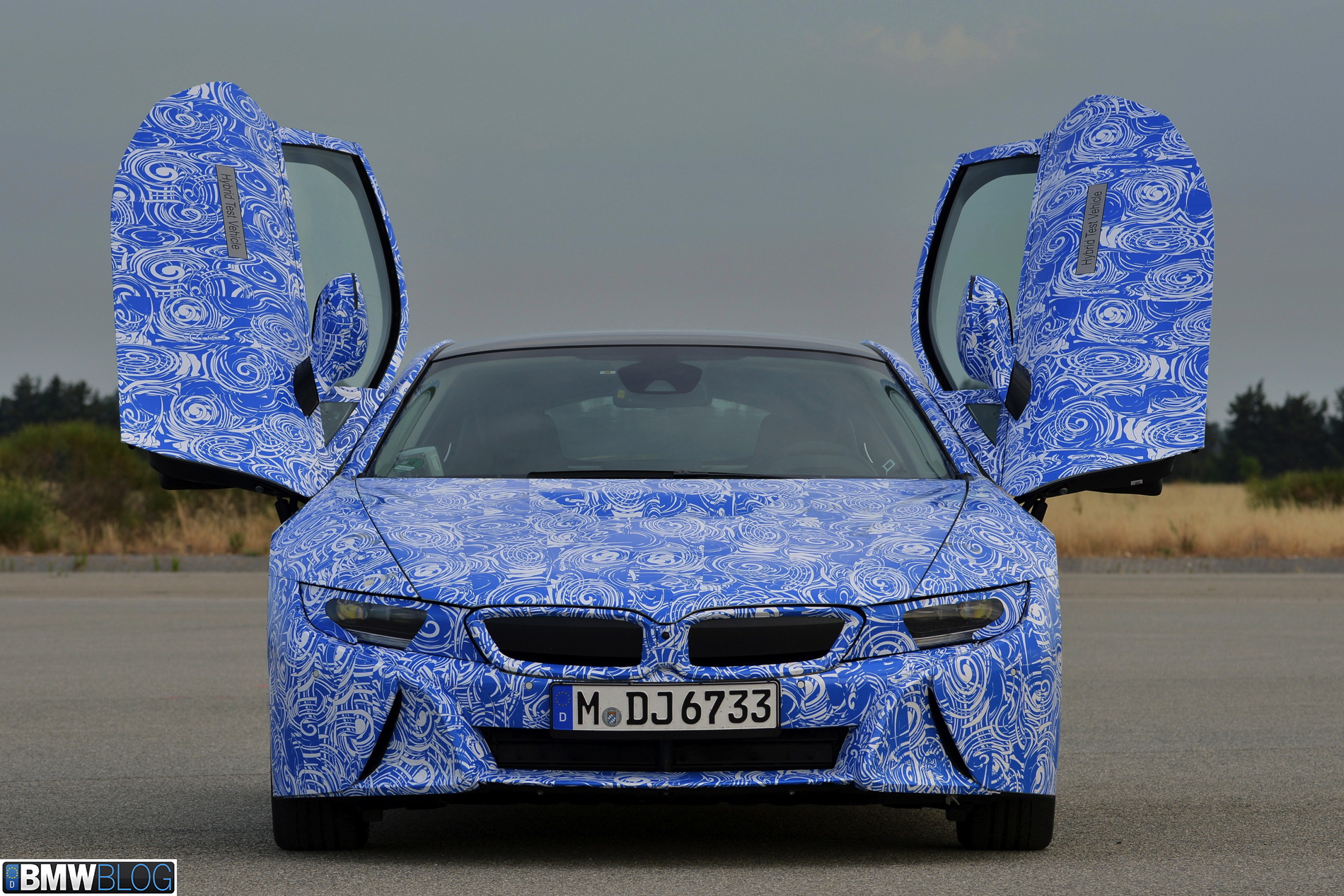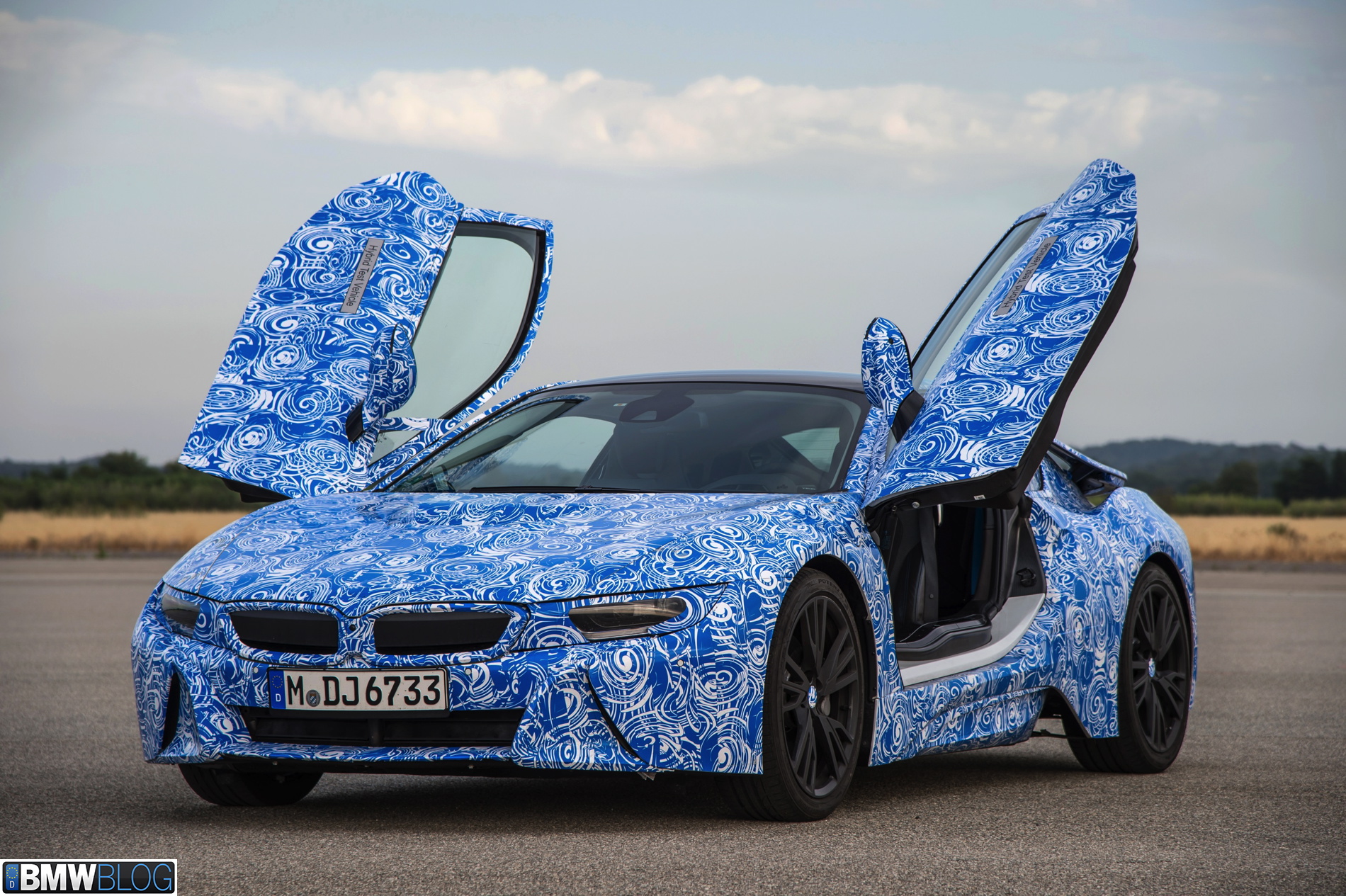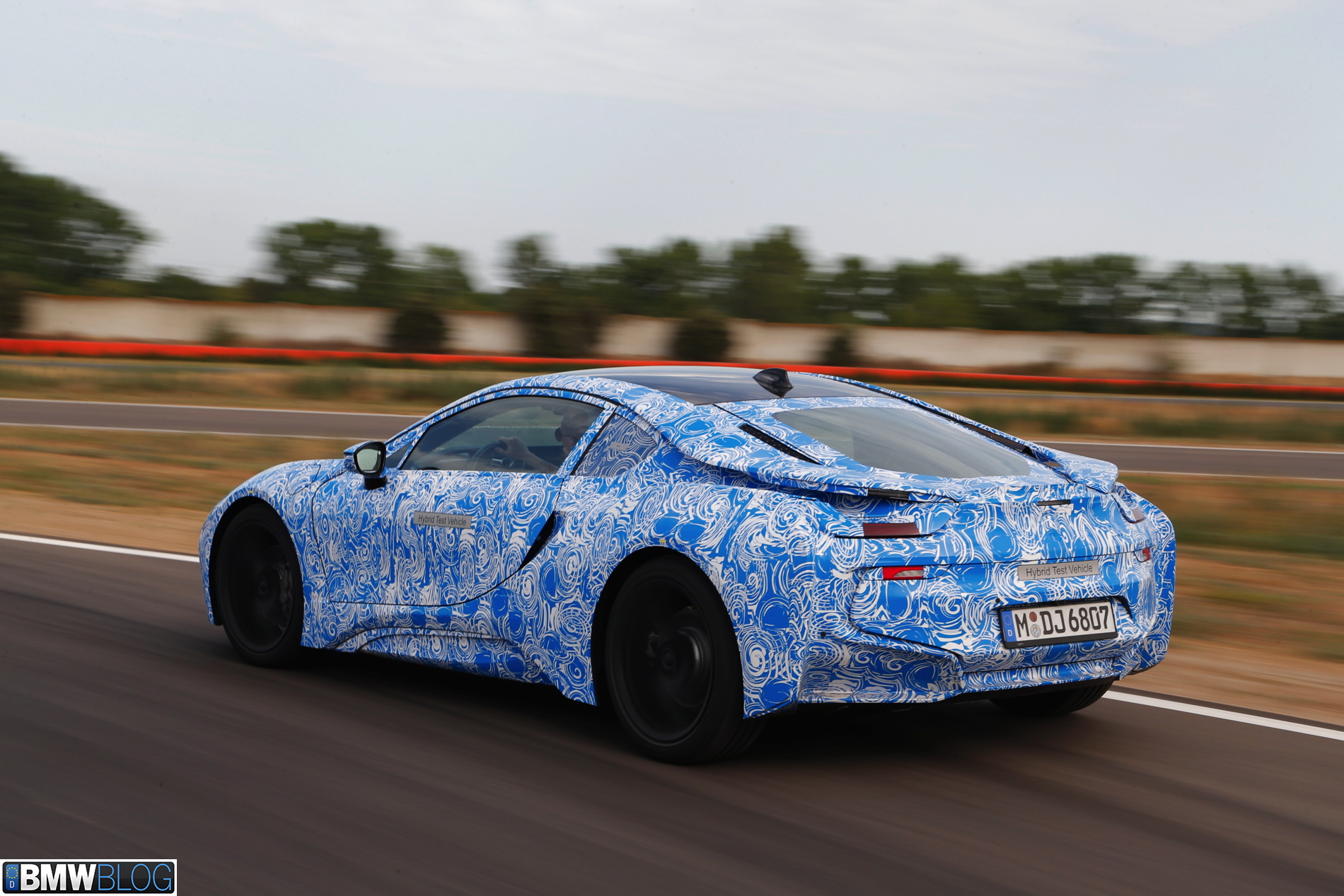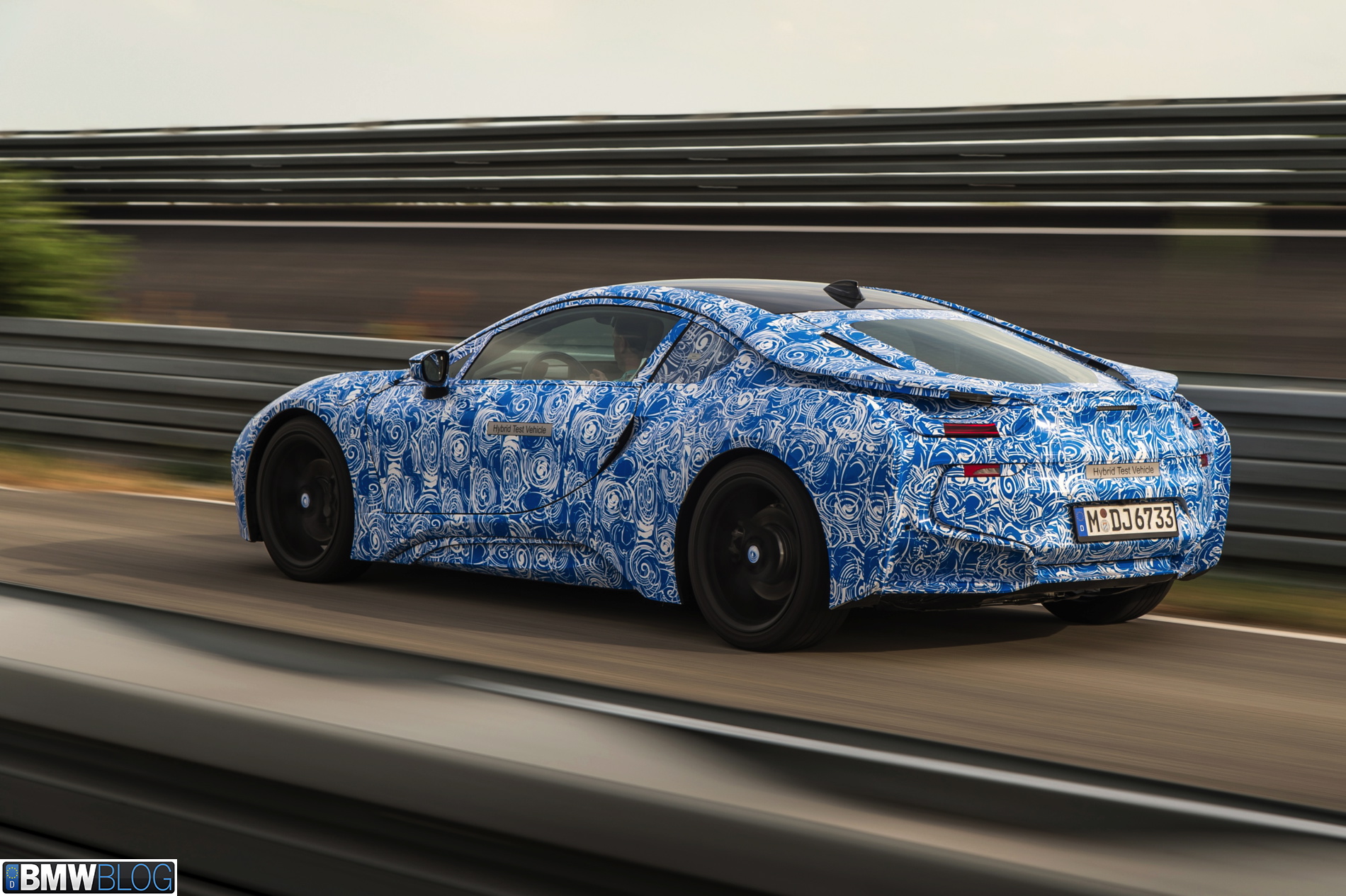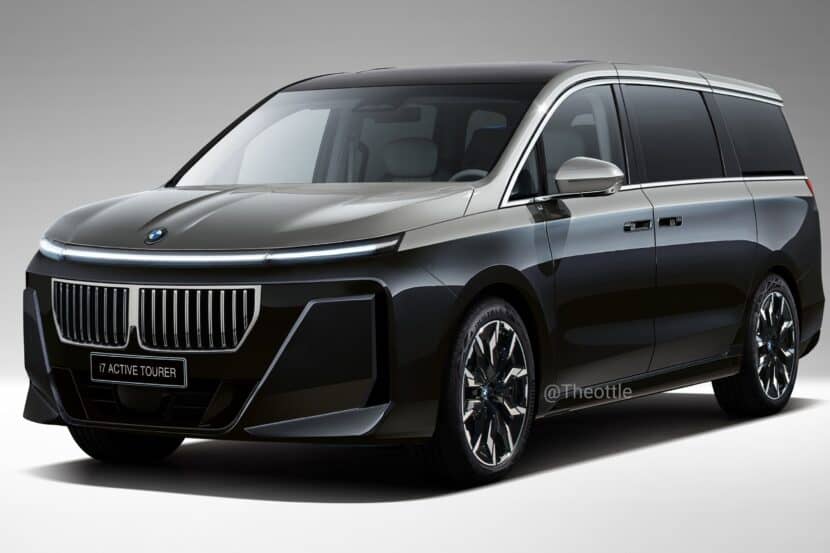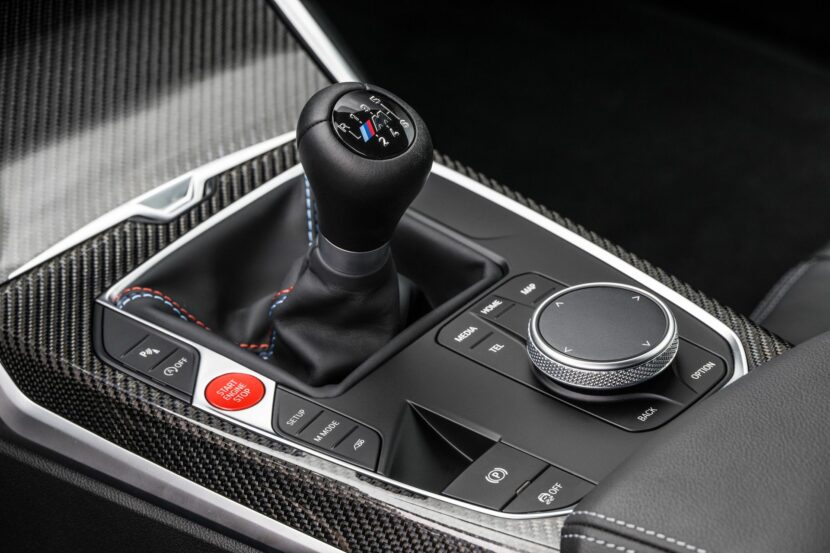At a driving event at the BMW Group’s Miramas test track in France, the BMW i presented a prototype of its second production vehicle, the BMW i8. BMW i is synonymous with visionary mobility concepts and a new definition of premium quality that is strongly focused on sustainability.
Following the world debut of the first production model, the BMW i3, the BMW Group’s next step will be to extend this revolutionary answer to the future challenges facing personal mobility to the sports car segment in the BMW i8. This plug-in hybrid model is the most progressive sports car of our time, extending the basic BMW i philosophy of sustainability to a new vehicle segment.
The BMW i8 fulfills the promise of The Ultimate Driving Machine in a revolutionary and mold-breaking form. This is reflected in a highly emotive design, dynamic sports car performance, and fuel efficiency and emissions figures worthy of a small car. Pairing an exceptionally lightweight, aerodynamically optimized body with cutting-edge BMW eDrive technology, a compact, turbocharged 1.5-liter BMW TwinPower Turbo gasoline engine and intelligent energy management, the BMW i8 marks the next stage in the evolution of the Efficient Dynamics strategy. Its revolutionary approach achieves an unprecedented balance between performance and fuel efficiency. Thanks to its carbon-fiber-reinforced plastic (CFRP) passenger cell, the BMW i8 sets new standards for a plug-in hybrid vehicle in terms of low weight. It can operate solely on electric power, which means no tailpipe emissions, and offers the dynamic performance of a sports car, with an expected 0 – 60 mph sprint time under 4.5 seconds.
The BMW i8 was designed from the outset as a plug-in hybrid sports car, with the emphasis on agile performance and outstanding efficiency. Its characteristic BMW i LifeDrive architecture provides the best possible basis for lightweight design. Its main components are the aluminum Drive module, which incorporates the internal combustion engine and electric motor, the battery, the power electronics and the chassis components, along with structural and crash functions, and the Life module, which essentially comprises the 2+2-seater CFRP passenger cell. This architecture also gives the BMW i8 a very low center of gravity and a near-perfect 50:50 axle load ratio, both of which increase its agility.
The BMW i8’s plug-in hybrid system is specific to this model. Developed and produced by the BMW Group, it marks the next step in the evolution of the Efficient Dynamics programme. A compact three-cylinder petrol engine with BMW TwinPower Turbo technology is combined with an electric drive system and a lithium-ion battery which can be recharged at a standard household power socket. The 231 hp (170 kW) gasoline engine sends its power to the rear wheels, while the 131 hp (96 kW) electric motor powers the front wheels. This configuration offers all-electric driving capability with a range of up to approx. 22 miles (35 kilometers) and a top speed of approximately 75 mph (120 km/h). With both drive systems engaged, it also offers road-hugging all-wheel-drive performance with powerful acceleration and dynamic torque vectoring during sporty cornering. The more powerful of the two powerplants drives the rear wheels. The hybrid system supplements this with power from the electric motor to deliver typical BMW driving pleasure combined with groundbreaking efficiency. Calculated using the EU test cycle for plug-in hybrid vehicles, the average fuel efficiency of the BMW i8 at model launch will be less than 2.5 liters/100 km, which equates to approximately 95 miles per US gallon, with CO2 emissions of less than 59 grams per kilometer.
Optimal balance between performance and fuel economy: BMW i8 as an exciting evolution of the Efficient Dynamics strategy.
It is now more than a decade since the BMW Group launched its Efficient Dynamics vehicle development strategy, whose aim is to significantly improve both the performance and the efficiency of new BMW Group models. Efficient Dynamics combines evolutionary advances in existing technologies with the development of new and revolutionary drive concepts. Efficient Dynamics solutions include efficient lightweight design and aerodynamic concepts, high-performance drive systems based on TwinPower Turbo technology and BMW eDrive, and intelligent management of all energy flows within the vehicle. The new, revolutionary technology now being introduced on models from BMW i will subsequently find its way into the vehicles of the BMW Group’s core brands.
BMW i is also setting benchmarks in the quest for zero CO2 emissions in urban driving. The research and development work carried out since 2007 as part of project i has laid the foundations for revolutionary mobility solutions strongly influenced by environmental, economic and social change around the world. The BMW Group is pursuing an integrated approach, as embodied in the BMW i brand, which aims to achieve the necessary balance between individual needs and the global mobility requirements of the future. The BMW i focus is squarely on all-electric and plug-in hybrid mobility. Groundbreaking design, intelligent lightweight engineering, typical BMW driving pleasure coupled with zero tailpipe emissions, intelligent energy management and resource- and energy-saving production processes are all combined into an innovative premium-quality package.
LifeDrive architecture with an aluminum chassis for the powertrain and a CFRP passenger cell: for more excitement, lower weight and optimized drag.
The LifeDrive architecture specially developed for BMW i vehicles offers the ideal platform for turning the tide of spiraling weight while at the same time achieving distinctive styling exclusive to BMW i. With a length of 184.6 inches (4,689 mm), a width of 76.5 inches (1,942 mm) and a height of 50.9 inches (1,293 mm), the BMW i8 has the proportions of a sports car. Its dynamic personality is also stressed by a long bonnet, conspicuous aerodynamic features, an elongated roofline, short overhangs and a long wheelbase of 110.2 inches (2,800 mm). Characteristic BMW i form language wraps up this groundbreaking combination of sporty performance and efficiency in a charismatic 2+2-seater design.
The BMW i8 combines a drag coefficient (Cd value) of 0.26 with outstanding aerodynamic balance. The finely honed air flow around all parts of the vehicle body makes for an excellent lift/drag ratio, resulting in superb driving dynamics and stability.
Intelligent lightweight design – from the overall concept down to the smallest detail.
With its combination of the aluminum Drive module and the CFRP passenger cell (Life module), the BMW i8 is also an excellent example of intelligent lightweight design – one of the guiding principles of the Efficient Dynamics strategy. Use of the lightweight high-tech material CFRP, which also offers excellent crash performance, brings weight savings of 50 percent over steel and around 30 percent over aluminum, with equivalent or improved strength. These savings offset the additional weight of the electric motor and the high-voltage battery, giving the BMW i8 a curb weight of less than 3,285 lbs (1,490 kilograms). The LifeDrive architecture also brings benefits in terms of weight distribution. The battery pack is situated low down in the middle of the vehicle, resulting in a low and central center of gravity, which improves safety. No other current model of a BMW Group brand has such a low center of gravity.
The front-rear axle load distribution maximizes agility with a near-perfect 50:50 axle load ratio. The compact electric motor, together with the transmission and power electronics, are situated in close proximity to the electrically powered front axle. The turbocharged gasoline engine, which is located together with its transmission in the rear of the BMW i8, likewise sends its power to the road via the shortest possible route, i.e. through the rear wheels. As a finishing touch to this excellent weight distribution, the lithium-ion battery pack is centrally located in the vehicle, slightly forward of the mid-point. In terms of crash safety, this is an ideal location for the battery, which is integrated in an aluminum housing.
The doors comprise a CFRP inner structure and an aluminum outer skin. This reduces the weight of the door by 50 percent compared with a conventional design. The high-quality, naturally tanned leather of the seats highlights the “next premium”, sustainable philosophy of BMW i. The magnesium instrument panel support saves weight on two fronts – firstly through intelligent design, leading to around 30 percent weight savings compared, for example, with the BMW 6 Series. In addition, the high structural rigidity provides a strengthening effect which allows the number of components to be reduced, thereby lowering weight by a further 10 percent. Innovative foam plastic technology used in the air conditioning ducts brings 60 percent weight savings over conventional components, while also improving acoustics thanks to its sound-absorbing properties.
The fact that the power electronics and electric motor are directly connected reduces the amount of wiring required, while partial use of aluminum wiring brings further weight reductions. Lightweight design is also a feature of the BMW i8’s chassis systems – including the wheels, where the standard-fitted 20-inch forged aluminum wheels combine aerodynamic design with weight savings. The rigorous application of the lightweight design strategy even extends to aluminum screws and bolts, which are around 45 percent lighter than corresponding steel components, with the same strength and functionality.
The BMW i8 is also the world’s first volume-produced vehicle to be equipped with chemically hardened glass. This innovative technology, to date used mainly in Smartphone manufacturing, results in very high strength. The partition between the passenger compartment and boot of the BMW i8 consists of two layers of chemically hardened glass, each of which is just 0.7 millimeters thick, with acoustic sheeting sandwiched between. In addition to excellent acoustic properties, a further advantage of this solution is weight savings of around 50 percent compared with conventional laminated glass.
For maximum driving pleasure and efficiency: BMW TwinPower Turbo engine and electric motor developed by the BMW Group.
The plug-in hybrid system of the BMW i8, which comprises a BMW TwinPower Turbo engine combined with BMW eDrive technology, offers the best of both worlds: excellent potential for improved efficiency and exciting, sporty driving characteristics. The BMW Group has developed not only the internal combustion engine and electric motor in-house but also the power electronics and the battery. This ensures that all these components offer high product and quality standards, based on the outstanding capabilities of the BMW Group in the field of powertrain research and development.
The revolutionary character of the BMW i8 is emphasized by a further innovation: the use of a new internal combustion engine which is making its debut in this model. The BMW i8 is the first BMW production model to be powered by a three-cylinder gasoline engine. This highly turbocharged unit is equipped with latest-generation BMW TwinPower Turbo technology. It is exceptionally compact and develops maximum power of 231 hp (170 kW). The resulting specific output of 154 hp (113 kW) per liter of displacement is on a par with high-performance sports car engines and is the highest of any engine produced by the BMW Group.
The new three-cylinder engine derives its typical characteristics from the BMW inline six-cylinder engines, to which it is closely related and which are noted for their eager power delivery, revving ability and refinement. The three-cylinder’s BMW TwinPower Turbo technology comprises a high-performance turbocharging system and direct gasoline injection with high-precision injectors positioned between the valves, along with VALVETRONIC throttle-less load control, which improves efficiency and response thanks to seamlessly variable valve lift control. Like a six-cylinder engine, the three-cylinder unit is free of first and second order inertial forces. The low roll torque, a typical feature of a three-cylinder design, is further reduced by a balancer shaft, while a multi-stage damper integrated in the automatic transmission ensures very smooth and refined running at low rpm. BMW TwinPower Turbo technology and low internal friction improve both fuel consumption and torque characteristics. Accelerator response is sharp and the three-cylinder unit quickly reaches its maximum torque of 236 lb-ft (320 Nm).
The BMW i8’s second power source is a hybrid synchronous electric motor specially developed and produced by the BMW Group for BMW i. The electric motor develops maximum power of 131 hp (96 kW) and produces its maximum torque of around 236 lb-ft (320 Nm) from standstill. Typical of an electric motor, responsive power is instantly available when starting and this continues into the higher load ranges. The linear power delivery, which extends right up to the high end of the rpm range, is down to a special motor design principle exclusive to BMW i. BMW eDrive technology refines and improves on the principle of the permanently excited synchronous motor via a special arrangement and size of the torque-producing components. This results in a self-magnetising effect normally confined to reluctance motors. This additional excitation ensures that the electromechanical field generated when current is applied remains stable even at high rpm.
As well as providing a power boost to assist the gasoline engine during acceleration, the electric motor can also power the vehicle by itself. Top speed is approximately 75 mph (120 km/h). The BMW i8 has a maximum driving range in this emission-free, virtually soundless, all-electric mode of up to 22 miles (35 kilometers). The motor derives its energy from the lithium-ion battery which is centrally mounted underneath the floor of the vehicle. The model-specific version of the high-voltage battery was developed and produced by the BMW Group. It has a liquid cooling system and can be recharged at a conventional household power socket, at a BMW i Wallbox or at a public charging station. In the US a full recharge takes approximately 3½ hours from a conventional 120 volt, 12 amp household circuit or approximately 1½ hours from a 220 volt Level 2 charger.
The BMW i8’s vehicle concept and powertrain control system mark it out as a progressive, revolutionary sports car. The BMW i8 always achieves the optimal balance between performance and efficiency, whatever the driving situation. When power demands allow, the high-voltage battery is recharged by the electric motor. The high-voltage starter-generator, responsible for starting the engine, can also be used as a generator to charge the battery, the necessary power being provided by the BMW TwinPower Turbo engine. The battery can also be recharged via the electric motor during overrun. These various processes help to prevent depletion of the BMW i8’s battery in order to maintain the electric drive power. The all-electric driving range is sufficient to cover most urban driving requirements. Out of town, the BMW i8 offers impressively sporty performance which is also very efficient thanks to the power-boosting support for the gasoline engine from the electric motor. With such versatility, the BMW i8 belongs to a new generation of sports cars which unites exciting performance with cutting-edge efficiency – to enhance both driving pleasure and sustainability.
Driving Experience Control and eDrive button: a choice of efficiency and performance characteristics – at the touch of a button.
The rear wheels of the BMW i8 are driven by the gasoline engine via a six-speed automatic transmission. The front wheels are driven by the electric motor via an integrated two-stage automatic transmission. Combined maximum power and torque of 362 hp (266 kW) and 420 lb-ft (570 Nm) meters respectively provide all-wheel-drive performance which is as dynamic as it is efficient. The BMW i8’s intelligent powertrain control system ensures perfect coordination of both power sources. The variable power-sharing between the internal combustion engine and the electric motor makes the driver aware of the sporty temperament of the BMW i8 at all times, while at the same time maximizing the energy efficiency of the overall system. Utilizing both power sources, the 0 – 60 mph acceleration time is expected to be less than 4.5 seconds. Linear acceleration is maintained even at higher speeds since the interplay between the two power sources efficiently absorbs any power flow interruptions when shifting gears. The BMW i8 has an electronically controlled top speed of 155 mph (250 km/h), which can be reached and maintained when the vehicle operates solely on the gasoline engine. Variable front-rear power splitting in line with changing driving conditions makes for excitingly dynamic cornering. On entering the corner, the power split is biased towards the rear wheels to improve turning precision. For more vigorous acceleration out of the corner, the powertrain controller returns to the default split as soon as the steering angle becomes smaller again. The BMW i8 also offers the driver unusual scope to adjust the drive and suspension settings of the vehicle in order to adapt the driving experience to his or her individual preferences. As well as the electronic gear selector for the automatic transmission, the driver can also use the Driving Experience Control switch – a familiar feature of the latest BMW models – or, exclusively to the BMW i8, the eDrive button.
Using the gear selector, the driver can either select position D for automated gear selection or can switch to SPORT mode. SPORT mode offers manual gear selection and at the same time switches to very sporty drive and suspension settings. In SPORT mode, the engine and electric motor deliver extra-sharp performance, accelerator response is faster and the power boost from the electric motor is maximized. And to keep the battery topped up, SPORT mode also activates maximum energy recuperation during overrun and braking: for this, the electric motor’s generator function, which recharges the battery using kinetic energy, switches to a more powerful setting. At the same time, gear change times are shortened and an extra-sporty setting is selected for the standard-fitted Dynamic Damper Control. Also in this mode, the programmable instrument cluster supplies further driving-related information in addition to the rev counter display.
The Driving Experience Control switch on the center console offers a choice of two settings. On starting, COMFORT mode is activated, which offers a balance between sporty performance and fuel efficiency, with unrestricted access to all convenience functions. Alternatively, at the touch of a button, ECO PRO mode can be engaged, which, on the BMW i8 as on other models, supports an efficiency-optimised driving style. The powertrain controller coordinates the cooperation between the gasoline engine and the electric motor for maximum fuel economy. On deceleration, the intelligent energy management system automatically decides, in line with the driving situation and vehicle status, whether to recuperate braking energy or to coast with the powertrain disengaged. At the same time, ECO PRO mode also programs electrical convenience functions such as the air conditioning, seat heating and heated mirrors to operate at minimum power consumption – but without compromising safety. The maximum driving range of the BMW i8 on a full fuel tank and with a fully charged battery is over 310 miles (500 km) in COMFORT mode. In ECO PRO mode, this can be increased by up to 20 percent. The BMW i8’s ECO PRO mode can also be used during all-electric operation. The vehicle is then powered solely by the electric motor. Only if the battery charge drops below a given level, or under sudden intense throttle application such as kickdown, is the internal combustion engine automatically activated. The driving mode selected at a given moment is indicated to the driver on the programmable instrument cluster by a distinctive color and by a different, mode-specific set of driving information. The three-dimensional appearance of the display adds to the futuristic look and feel of the vehicle as a whole.
High-quality chassis technology, DSC and Dynamic Damper Control as standard.
The high-end chassis and suspension technology of the BMW i8 is based on a double-track control arm front axle and a five-link rear axle, whose aluminum components and geometry are specially configured for intelligent weight savings. The electromechanical power steering offers easy manoeuvring in town and typical sports car-style high-speed steering precision. Also standard is Dynamic Damper Control: the electronically operated dampers change their characteristics according to the selected driving mode to deliver the desired vehicle dynamics. The DSC (Dynamic Stability Control) stability system includes the Anti-lock Braking System (ABS), Cornering Brake Control (CBC), Dynamic Brake Control (DBC), Brake Assist, Brake Standby, Start-Off Assistant, Fading Compensation and the Brake Drying function. The push button-activated Dynamic Traction Control (DTC) system raises the DSC thresholds, allowing some controlled drive wheel slippage for easier start-off on snow or loose ground, or for extra-dynamic cornering.
The extraordinary BMW i8 will make its world debut at the Frankfurt Motor Show and arrive in BMW showrooms in 2014.
| BMW i8 Technical specifications (preliminary). BMW i8 | |||||
| Body | |||||
| No. of doors/seats | 2 / 4 | ||||
| Length/width/height | in. mm | 184.6/76.5/50.9 4689 / 1942 / 1293 | |||
| Wheelbase | in. (mm) | 110.2 (2800) | |||
| Weight, unladen (DIN) | lbs (kg) | 3285 (1490) | |||
| Air resistance | Cd | 0.26 | |||
| Drive system | |||||
| Technology combustion engine | BMW TwinPower Turbo turbocharger, High Precision Direct Injection VALVETRONIC fully variable valve control | ||||
| Config/No of cyls/valves | In-line / 3 / 4 | ||||
| Capacity, effective | cc | 1499 | |||
| Output | hp/kW | 231/170 | |||
| Torque | lb-ft/Nm | 236/320 | |||
| Technology electric motor | BMW eDrive technology: hybrid synchronous motor with power electronics, integrated charging module and generator mode for recuperation | ||||
| Output | hp/kW | 131/96 | |||
| Torque | lb-ft/Nm | 184/250 | |||
| System output | kW/hp | 362/266 | |||
| Torque | lb-ft/Nm | 420/570 | |||
| High-voltage battery | |||||
| Storage technology | Lithium-ion | ||||
| Driving dynamics | |||||
| Drive concept | Hybrid-specific all-wheel drive, combustion engine driving the rear wheels, electric motor driving the front wheels | ||||
| Tires front/rear | 195/50 R20 / 215/45 R20 | ||||
| Rims front/rear | 7J x 20 alloy / 7.5J x 20 alloy | ||||
| Transmission | |||||
| Type of transmission combustion engine | 6-speed automatic | ||||
| Type of transmission electric motor | Automatic, two-stage | ||||
| Performance | |||||
| Acceleration 0–60 mph | s | < 4.5 | |||
| 50-75 mph | s | < 4.5 | |||
| Top speed | mph (km/h) | 155 (250) | |||
| Top speed electric | mph (km/h) | 75 (120) | |||
| Range | miles (km) | > 310 (500) | |||
| Range electric | km | approx 35 | |||
| Efficiency in EU cycle | |||||
| Combined | mpg (US) | </= 95 | |||
| CO2 | g/km | </= 59 | |||



